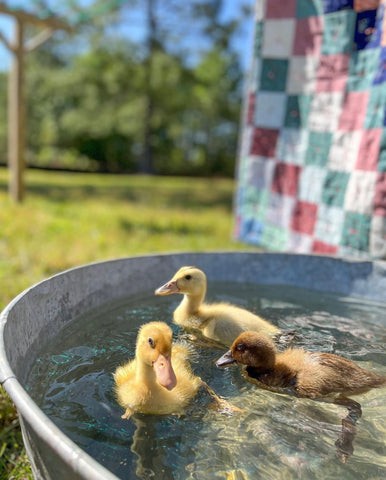Ducks are truly delightful creatures. Their playful antics in water, adorable waddling walks, and charming quacks bring a unique joy to any pet owner. Many even find themselves preferring ducks to chickens! If you’re considering welcoming these web-footed friends into your life, understanding How To Take Care Of Ducks, especially ducklings, is crucial. This beginner’s guide will walk you through the essential steps to ensure your ducklings grow into healthy, happy ducks.
Getting Started: Bringing Ducklings Home
The first step in duck ownership is, naturally, getting your ducks! Ducks are inherently social animals, thriving in company. Therefore, acquiring at least two ducklings is highly recommended to prevent loneliness. A small flock of 2-4 ducklings is an excellent starting point for beginners.
When selecting your ducklings, consider the male-to-female ratio, particularly if you plan to keep them long-term. A ratio of one male for every 3-5 females is ideal to avoid over-mating and potential injuries to the females. Alternatively, if breeding isn’t your goal, you can opt for an all-female or all-male group.
Purchasing ducklings from local feed stores can be convenient, but often, ducklings aren’t sexed at this stage. This can lead to an imbalance in your male-to-female ratio as they mature. For a more controlled selection, ordering from a reputable hatchery like My Pet Chicken is a reliable option. Hatcheries allow you to specify the sex of your ducklings, ensuring a balanced flock right from the start.
Once your fluffy ducklings arrive, ensuring they settle in comfortably is paramount. Their brooder setup is their initial home, and getting it right is crucial for their well-being.
Setting Up the Brooder: Creating a Comfy Home
Just like chicks, ducklings require a brooder for the first 7-9 weeks of their lives, or until they are fully feathered and capable of regulating their body temperature outdoors. An indoor brooder provides a safe, warm, and controlled environment during their vulnerable early stages.
Essential brooder components include bedding, a feeder, a waterer, and a heat source. Pine shavings are a popular and effective bedding choice. For the brooder itself, a simple 28-gallon galvanized tub or a large plastic storage container works well. Many keepers find it convenient to set up the brooder in a spare bathroom or utility room for easy access and cleaning.
Maintaining the correct temperature is vital, especially in the initial weeks. While some guides recommend precise temperature measurements and weekly reductions, a more practical approach is to use a heat lamp positioned to warm only a portion of the brooder. This allows ducklings to move freely between warmer and cooler zones, regulating their own temperature as needed. Observe your ducklings’ behavior: if they huddle together tightly and shiver, they need more warmth; if they are panting or spread out and avoiding the heat source, it’s too warm. Adjust the heat lamp accordingly to ensure they are comfortable.
Alt text: Ducklings enjoying their spacious tub brooder setup with food, water, and a heat lamp for warmth.
Feeding Your Ducklings: Nutrition is Key
Proper nutrition is fundamental to raising healthy ducklings. You have two primary feeding options: waterfowl-specific feed or chick starter/grower feed. If opting for chick feed, always choose the non-medicated variety. Ducks consume larger quantities of food than chicks, increasing the risk of medication overdose if medicated feed is used.
A critical nutritional difference is ducks’ higher niacin requirement compared to chicks. When using chick starter, niacin supplementation is essential until they reach around 20 weeks of age. A readily available supplement is Brewer’s Yeast. Mixing approximately 1.5 tablespoons of Brewer’s Yeast per cup of feed ensures adequate niacin intake.
Protein requirements also change as ducklings grow. For the first three weeks, feed a diet containing 18-22% protein. Reduce this to 15-16% protein until they are 18 weeks old, and then switch to a 16% protein layer feed for adult ducks.
Water is Essential: Hydration and Hygiene
Water is arguably even more crucial for ducklings than food. They drink substantial amounts and, importantly, need to fully submerge their bills in water to keep their nostrils clean. Ensure their waterer is deep and wide enough to allow this natural cleaning behavior. Be prepared for frequent refills and bedding changes, as ducklings are enthusiastic splashers!
Regularly check your ducklings for “pasty butt,” a condition particularly common in ducklings that have experienced shipping stress. Pasty butt occurs when stool hardens and blocks the vent, preventing waste excretion. To check, gently turn each duckling over and examine their vent area. If hardened stool is present, carefully soak the area with warm water and gently wipe it away. Avoid pulling, which can damage their delicate down. Untreated pasty butt can be fatal, so prompt attention is vital.
Duckling Hygiene and Health
Maintaining a clean brooder environment is key to preventing illness. Change the bedding frequently to keep it dry and reduce ammonia buildup.
Once ducklings are a week old, introduce them to supervised swimming sessions. Start with shallow, warm water in a bathtub or sink. Always supervise them closely during swim time, as ducklings can tire quickly and potentially drown. Limit initial sessions to short periods.
Ducklings lack the waterproofing oil of adult ducks until around 4 weeks old. After swimming, they must be thoroughly dried with a towel and returned immediately to their warm brooder to prevent chilling. Chilling can be very dangerous for young ducklings.
Transitioning Outdoors
As your ducklings grow and feather out, they will gradually need less supplemental heat and will be ready to transition to an outdoor environment. This typically occurs around 6 weeks of age, or when they are fully feathered, depending on your local climate and weather conditions. Ensure the weather is consistently warm and there is no risk of sudden cold snaps before moving them outside permanently.
Their outdoor setup should include secure housing that protects them from predators and inclement weather. A coop or shed with adequate space for roosting and shelter is essential. They will also need access to a safe outdoor area for foraging and, of course, water for swimming and playing.
Conclusion: Enjoying Your Ducks
Raising ducklings is a rewarding journey. While it requires dedication and attention to detail, the joy of watching them grow, play, and become beloved members of your backyard is immeasurable. By following these guidelines on how to take care of ducks, you’ll be well-equipped to provide a nurturing environment and enjoy the delightful companionship of your feathered friends for years to come.
Alt text: A helpful checklist summarizing key aspects of duckling care for new owners.

